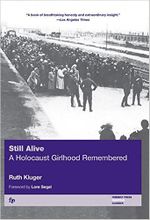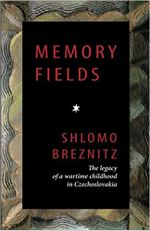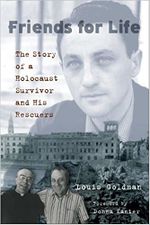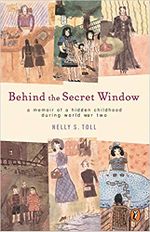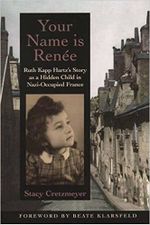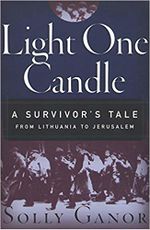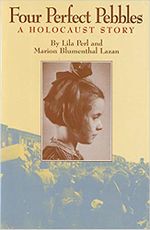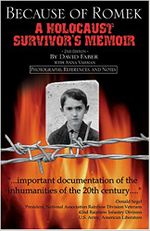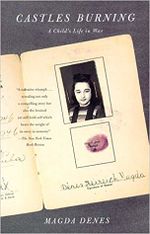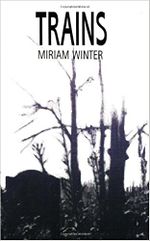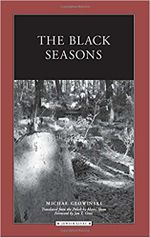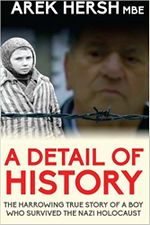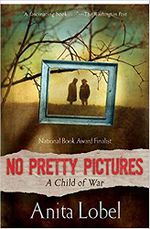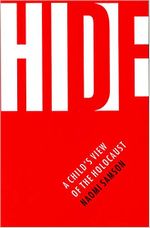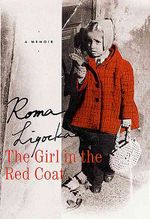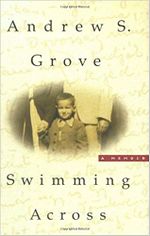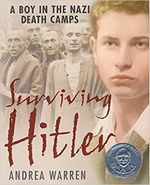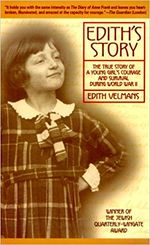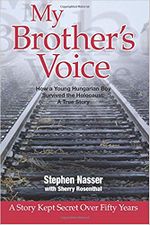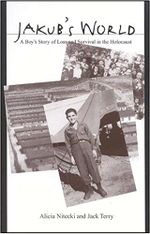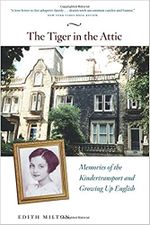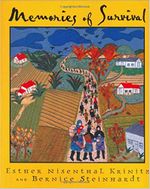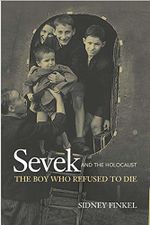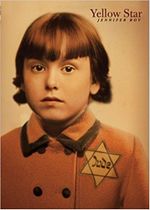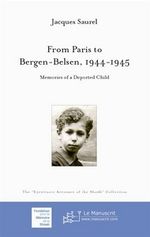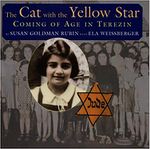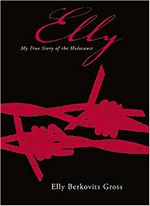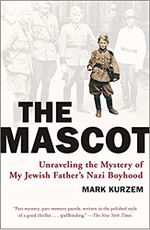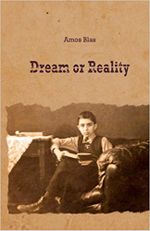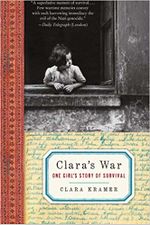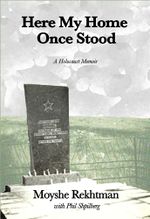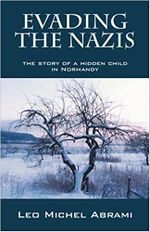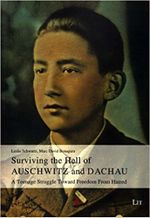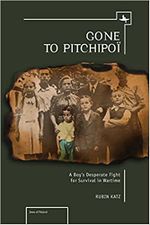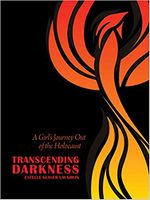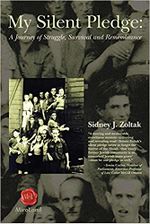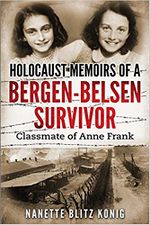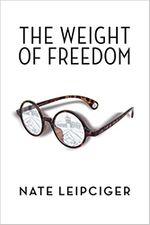Category:Holocaust Children's Memoirs (subject)
Holocaust Children's Memoirs
- Holocaust Children -- Holocaust Children's Biographies -- Holocaust Children's Diaries -- Holocaust Children's Movies
1950s
1956
- Elie Wiesel (M / Romania, 1928-2016). און די וועלט האָט געשוויגן / Un di Velt Hot Geshvign ["And the World Remained Silent"] <Yiddish> (Buenos Aires: Central Union of Polish Jews in Argentina, 1956). Revised French ed. La Nuit (Paris: Les Éditions de Minuit, 1960). English ed. The Night, trans. Stella Rodway (New York: Hill & Wang; and London: MacGibbon & Kee, 1960). International bestseller. Translated in more than 20 languages.
1958
- Thomas Geve / Stefan Cohn (M / Germany, 1929). Youth in Chains (Jerusalem : R. Mass, 1958).
1959
- Edith Bruck / Edith Steinschreiber (F / Hungary, 1932). Chi ti ama così <Italian> (Milan: Lerici, 1959). English ed.: Who Loves You Like This, trans. Thomas Kelso (Philadelphia, Pa. : Paul Dry Books, 2001).
1960s
1967
- Halina Birenbaum (F / Poland, 1929), Nadzieja umiera ostatnia (1967). English ed. Hope Is the Last to Die (1994)
- Jack Kuper (M / Poland, 1932). Child of the Holocaust (London: Routledge & K. Paul, 1967).
- Beni Virtzberg (M / Germany, Poland, 1928-1968). Milayl Habedolah Ve'ad Laylot Hakrav [From Kristallnacht to the Nights of Battle] (Jerusalem: Masada Press, 1967). English ed. From Death to Battle: Auschwitz Survivor and Palmach Fighter (Jerusalem: Yad Vashem, 2017).
1970s
1972
- Johanna Reiss (F / Netherlands, 1932). The Upstairs Room (1972). Juvenile audience.
1973
- Joseph Joffo (M / France, 1931-2018).Un Sac de billes <French> (1973). English trans. A Bag of Marbles (Boston: Houghton Mifflin, 1974).
1975
- Imre Kertész (Hungary, 1929-2016). Sorstalanság <Hungarian> (1975). English trans. Fateless / Fatelessness (1992).
1977
- Sara Zyskind / Sara Rachela Plagier (F / Poland, 1927-1995). העטרה שאבדה : בגיטו לודז׳ ובמחנות / ha-ʻAṭarah she-avdah: be-geṭo Lodz' uva-maḥanot <Hebrew> (Tel Aviv: Bet loḥame ha-getaʼot ṿe-hotsaʼat ha-Ḳibuts ha-meʼuḥad, 1977). English trans. Stolen Years (Minneapolis, MN: Lerner Publications Co., 1981)
1978
- Saul Friedländer (M / France, 1932). Quand vient le souvenir <French> (1978). English ed. When Memory Comes (New York : Farrar, Straus, Giroux, 1979). Also translated into German, Hebrew, Spanish, and Italian.
- Jona Oberski (M / Netherlands, 1938). Kinderjaren <Dutch> (1978). English trans. Childhood. Garden City, NY: Doubleday, 1983 / repr. New York, NY: Penguin Books, 2014. Translated into English, French, German, Italian, Spanish
- John G. Stoessinger (M / Austria, 1927-2017). Night Journey: A Story of Survival and Deliverance (1978). New ed. "From Holocaust to Harvard"
1979
- Samuel Pisar (M / Poland, 1929-2015). Le sang de l'espoir <French> (Paris: Laffont, 1979). English trans. Of Blood and Hope (Boston : Little, Brown, 1980).
1980s
1980
- Ben Edelbaum (M / Poland, 1928-1990). Growing up in the Holocaust (Kansas City, MO : Edelbaum, 1980). Adapted by Margaret Baldwin for juvenile audience: The Boys Who Saved the Children (New York: J. Messner, 1981).
- Livia Bitton-Jackson / Elli L. Friedmann (F / Czechia). Elli : Coming of Age in the Holocaust (New York : Times Books, 1980). In 1997 the author wrote a version of her autobiography for juvenile audience. I Have Lived a Thousand Years: Growing Up in the Holocaust (New York, NY: Simon & Schuster Books for Young Readers, 1997).
1981
- Uri Orlev (M / Poland, 1931). האי ברחוב הציפורי <Hebrew> (Jerusalem: 1981) is a semi-autobiographical novel written by Holocaust survivor Uri Orlev (b.1931). English trans. The Island on Bird Street (Boston, MA: Houghton Mifflin, 1984).
- Aranka Siegal (F / Hungary, 1930). Upon the Head of the Goat: A Childhood in Hungary (New York, NY: Farrar Straus Giroux, 1981).
1983
- Frida Weinstein / Frida Scheps (F / France, 1936). J'habitais rue des Jardins Saint-Paul (Paris: Balland, 1983). English ed. A Hidden Childhood, 1942-1945 (New York : Hill and Wang, 1985).
1985
- Marek Herman (M / Poland, 1927). From the Alps to the Red sea (Israel:Ghetto Fighters' Museum, 1985). Repr. 2020.
1986
- Inge Auerbacher (F / Germany, 1934). I Am a Star: Child of the Holocaust (New York, NY: Prentice-Hall Books for Young Readers, 1986) is the memoir written by Holocaust survivor Inge Auerbacher (b.1934).
- Janina Bauman (F / Poland, 1928). Winter in the Morning: a young girl's life in the Warsaw ghetto and beyond (1986).
1986
- Ruth Minsky Sender / Riva Minska (F / Poland, 1926). The Cage (1986).
1988
- Alicia Appleman-Jurman (F / Poland, 1930-2017). Alicia (Toronto, and New York : Bantam Books, 1988).
- Dov Freiberg (Poland, 1927-2008). To Survive Sobibor (1988).
- Eva Schloss (F / Netherlands, 1929). Eva's Story: A Survivor's Tale (New York : St. Martin's Press, 1988).
1989
- Yehuda Nir (M / Poland, 1930-2014).The Lost Childhood (San Diego : Harcourt Brace Jovanovich, 1989) is the memoir written by Holocaust survivor Yehuda Nir (1930-2014).
1990s
1991
La Petite Fille Du Vel d'Hiv (1991) is a memoir written by Holocaust survivor Annette Muller.
KEYWORDS: <France>
1992
Weiter Leben: eine Jugend <German> (1992) is a memoir written by Holocaust survivor Ruth Klüger (b.1931).
English trans. Still Alive: A Holocaust Girlhood Remembered (New York, NY: Feminist Press at the City University of New York, 2001)
KEYWORDS: <Austria> <Theresienstadt> <Auschwitz> <Gross-Rosen>
"Swept up as a child in the events of Nazi-era Europe, Kluger saw her family's comfortable Vienna existence destroyed. Despite her shattered childhood, Kluger eventually reclaimed her life. A coming-of-age story that delves into the unsentimental observations of childhood, "Still Alive" rejects easy assumptions about history as Kluger relates how she and her family survived the Holocaust."--Publisher description.
Ruth Klüger (Austria, 1931), Holocaust survivor
1993
Sedot ha-zikaron (Tel Aviv : `Am `oved, 1993) is the memoir written by Holocaust survivor Shlomo Breznitz (b.1936).
English ed. Memory Fields: The Legacy of a Wartime Childhood in Czechoslovakia (New York: Knopf, 1993). Also translated into German.
KEYWORDS: <Czechia> <Hidden Children> <Catholic Schools>
"Memory Fields recounts Shlomo Breznitz’s devastating experiences upon being placed in a Sisters of Saint Vincent orphanage just hours before his parents were sent to Auschwitz. He tells of events with other orphans, his teacher, classmates, the prelate and dreaded visits by Nazi officers periodically searching for Jewish children. He describes overwhelming feelings of isolation and loneliness, and persistent dread of being discovered. Interwoven throughout the book, Breznitz, the psychologist, draws on his history and explores the nature of cruelty and kindness, of stifling fear and outstanding courage, and the ways in which memory shapes our lives. University of Haifa psychology professor Breznitz, who was caught up in the Holocaust as a child, has written a spare and eloquent memoir of his experiences. Born into a Jewish family in Bratislava, Czechoslovakia, he narrowly avoided transport to a concentration camp, because his parents, who were soon shipped to Auschwitz, managed to place the six-year-old Shlomo and his 10-year-old sister, Judith, in a Catholic orphanage, where they remained until the end of the war. There Shlomo strove to become a good Christian, hiding his circumcision from the other boys, who frequently treated him cruelly, and memorizing the Catholic litany so well that he was chosen to recite for the prelate. The pain of his memories of the convent was reinforced by an anti-Semitic incident that took place in 1959 when the author was traveling through Hungary as a member of the Israeli student chess team. The book is a moving contribution to Holocaust literature."--Publisher description.
"Moving artfully and easily from past to present, from a child's perspective to an adult's, Shlomo Breznitz's many voices relate this poignant, gripping, and often terrifying memoir. Caught in Czechoslovakia during the Holocaust, Breznitz and his family moved from village to village until it became clear that there was no escaping the Nazis. Before they were sent to Auschwitz, however, Breznitz's parents persuaded the Sisters of Saint Vincent to take their two recently converted children into the convent's orphanage. Shlomo - called Juri - was just six years old. Separated from his parents and from his sister, Judith (the nuns segregated the sexes, and communication between them was rarely allowed), Juri recounts his often devastating experiences with the other orphans, the nuns, his teacher and classmates at the village school, the prelate and the mother superior, and the Nazi officers who periodically visited the orphanage. He describes his overwhelming feelings of isolation and loneliness, his persistent dread of being found out as a "stinking Jew" (constantly hiding his circumcision), his earnest determination to be a good Catholic, and the crushing sense of danger that loomed over him at every moment. Memory Fields, however, goes beyond its recollections of childhood. It speaks also for Breznitz the psychologist, as he explores the nature of cruelty and kindness, of stifling fear and outstanding courage, of memory and the ways in which it shapes our lives. In the last chapter of the book, almost fifty years later Breznitz returns to Czechoslovakia and revisits the places so vivid in his memory, in hopes of finding the nuns who saved his and his sister's life. A stunning and evocative story, beautifully told."--Publisher description.
Shlomo Breznitz (1936)
1993
Amici per la vita (Firenze : Ed. Sp44, 1993) is the memoir written by Holocaust survivor Louis Goldman (1925-1996), regarding himself and his younger brother Harry Goldman (1931-1948).
English ed. Friends for Life: The Story of a Holocaust Survivor and His Rescuers (New York : Paulist Press, 2008)
KEYWORDS: <Germany> <Refugees> <France> <Italy> <Hidden Children> <Christian Orphanage>
"This extraordinary book is a tribute to a group of young Catholic priests who, for two years, from 1943 to 1945, risked their life to save Jews from the Nazis. The author, a noted photographer, came to the US after the war and became a photographer for the entertainment arts. However, he was compelled to recount the story of the events of his life and family, which survived the Holocaust in Italy, and the Italian clergy who had saved them. His memories are raw, agonizing, sorrowful, yet touched with poignant hope, and the relief of eventual liberation Readers will not fail to be moved by these stirring and painful memories that are marked with the example of these courageous priests who spared no efforts to save Goldman's family's life, as well as the lives of many others. Absorbing, wonderfully written, and, heart-rending, and, ultimately, life affirming, this book deserves to be widely read. A comparison with Anne Frank is not overstating its merit."--Publisher description.
Louis Goldman (1925-1996) and his brother Harry Goldman (1931-1948) survived as refugees in France and in hiding in Italy, with the help of some Catholic priests. Harry died in the Israel’s War of Independence. Louis moved to the United States where he had a successful career as a photographer.
1993
Behind the Secret Window: A Memoir of a Hidden Childhood during World War Two (New York: Dial Books, 1993) is the memoir written by Holocaust survivor Nelly S. Toll (1935), regarding herself and her mother.
KEYWORDS: <Poland> <Lvov Ghetto> <Hidden Children> <Christian Families>
"The author recalls her experiences when she and her mother were hidden from the Nazis by a Gentile couple in Lwów, Poland, during World War II ... Illustrated with Nelly's original watercolors, this powerful memoir tells the true story of how a little girl's imagination helped her survive World War II ... The Nazis come to Poland when Nelly is six. By the time she turns eight, the events of World War II have taken almost everyone she loves. Scared, lonely, and running from the Nazis, Nelly hides in the bedroom of a Gentile couple in Lwow, Poland. For over a year, she lives in fear of discovery, writing in her diary and painting pictures of a fantasy world filled with open skies and happy families ... For 13 months during World War II, the author and her mother were hidden from the Nazis. Like Anne Frank, Nelly kept a diary and through that outlet transformed her grim reality into an enchanting fantasy world ... Without emphasizing horror and loss, Toll conveys the effects of human evil and human folly, summoning up the forces of tragedy and courage ... In Toll's remembrance, art equals hope: her happy family pictures, painted in the secret room where she and her mother hid from the Nazis and the Poles, show extraordinary preteen talent as well as the will to survive"--Publisher description.
Nelly S. Toll (Poland, 1935), Holocaust survivor
1994
Dank meiner Mutter <German> (Frankfurt am Main: Alibaba, 1994) is a memoir written in German by Holocaust survivor Schoschana Rabinovici (Suzanne Weksler; 1932-2019). Originally published in German in 1994.
English trans. Thanks to My Mother (New York, NY: Puffin, 1998).
KEYWORDS: <Lithuania> <Vilnius Ghetto>
"Susie Weksler was only eight when Hitler's forces invaded her Lithuanian city of Vilnius. Over the next few years, she endured starvation, brutality, and forced labor in three concentration camps. With courage and ingenuity, Susie's mother helped her to survive--by disguising her as an adult to fool the camp guards, finding food to add to their scarce rations, and giving her the will to endure. This harrowing memoir portrays the best and worst of humanity in heartbreaking scenes you will never forget."--Publisher description.
Schoschana Rabinovici (1932-2019) was born in Paris on November 14, 1932 where her parents were completing their studies. After the Wekslers returned to Vilnius, Susie attended Jewish school until the German occupation of the city in June 1941. She survived Vilnius Ghetto and the Kaiserwald and Stutthof Nazi concentration camps as a young girl (ages 8 to 12). After the war Weksler attended school in Poland and in 1950 she immigrated to Israel. She married David Rabinovici in 1953. Suzanne Weksler, now Schoschana Rabinovici, lived in Tel Aviv and Vienna since 1964, until her death in 2019.
1994
Your Name Is Renée: Ruth Kapp Hartz's Story as a Hidden Child in Nazi-Occupied France (New York : Oxford University Press, 1994) is the story of Holocaust survivor Ruth Kapp Hartz (b.1937) written by Stacy Cretzmeyer.
KEYWORDS: <France> <Hidden Children> <Christian Orphanage>
"Tells the story of Ruth Kapp, a young Jewish girl in Nazi-occupied France in 1941, who, after being separated from her family, lived out the war hidden in a Catholic convent until being reunited with her parents in the final months of the conflict ... In Nazi-occupied France in 1941, four-year-old Ruth Kapp learns that it is dangerous to use her own name. "Remember," her older cousin Jeannette warns her, "your name is Renee and you are French!" A deeply personal book, this true story recounts the chilling experiences of a young Jewish girl during the Holocaust. The Kapp family flees one home after another, helped by simple, ordinary people from the French countryside who risk their lives to protect them. Eventually the family is forced to separate, and young Ruth survives the war in an orphanage where she is not allowed to see or even mention her parents. Without the trappings of lofty language or the faceless perspective of history, this first-person account poignantly recreates the terror of war seen through the eyes of an innocent child. Your Name Is Renee is a tale of suffering and redemption, fear and hope."--Publisher description.
Ruth Kapp Hartz (b.1937) -- Ruth (Renee) Hartz, nee Kapp, born in Palestine of German-Jewish parents in 1937, moved with her family to Paris in 1938. After the invasion of France in 1940, they were sent with other non-French to Colombers, a sports stadium outside of Paris. Her father avoided deportation by joining the French Foreign Legion in Morocco. With the help of the Resistances, Ruth and her mother fled to Normandy, with false papers, hiding on a farm, then to Toulouse and Arthes near Albi in the French Free Zone, where father joined them in 1942. She describes flight, hunger and painful separation from her parents when she was hidden in a Sorēze convent in Sortčze. After one year, the family reunited and was helped with food and hiding by two generations of a Catholic family, with whom they remain in contact. After the war, the family moved to Paris. Ruth experienced antisemitism in school and later at the Sorbonne and found protection hiding her Jewishness as she had during the war. Joining the Jewish scouts (Les Éclaireurs) and WIZO reinforced her Jewish identity. She emigrated to the US in 1958.
1995
- Miriam Akavia (F / Poland, 1927-2015). An End to Childhood (1995).
1995
Light One Candle: A Survivor's Tale from Lithuania to Jerusalem (1995) is a memoir written by Holocaust survivor Solly Ganor (b.1928).
KEYWORDS: <Lithuania> <Kaunas Ghetto>
"Forty-seven years after he was found half-dead in the snow, following a death march from Dachau, Solly Ganor again came face to face with his rescuer Clarence Matsumura at a reunion of Holocaust survivors and their American liberators. That meeting proved a catharsis, enabling Ganor to confront for the first time the catalogue of horrors he experienced during the Second World War. Beginning in prewar Lithuania, Light One Candle tells of the ominous changes that took place once Hitler came to power in 1933, of Chiune Sugihara, the Japanese consul who wrote thousands of exit visas for Jews fleeing the Nazi onslaught, of the brutal conditions in the Kaunas ghetto where Ganor spent most of the war, and of Stutthoff and Dachau, the concentration camps he was shuttled to and from in the last, desperate days of the war. Unflinching in its depiction of evil but uplifting in its story of the survival of the human spirit, Light One Candle is a gripping memoir that waited fifty years to be told."--Publisher description.
Solly Ganor (b.1928)
1996
Ein Kind unserer Zeit (Frankfurt am Main: dipa-Verl., 1996) is a memoir written by Holocaust survivor Ruth L. David (b.1929).
English ed. Child of Our Time: A Young Girl's Flight from the Holocaust (London: Tauris, 2002).
KEYWORDS: <Germany> <Kindertransport>
"Child of Our Time is the inspiring story of a little girl caught in the vortex of one of history’s great horrors. Plucked from deep rural Germany, after witnessing the horror of Kristallnacht and her family’s eviction from its village, Ruth David was sent to England as part of the Kindertransport—one of the few routes to safety and survival for many children who were to lose their parents in the Holocaust ... As a child of the Holocaust, David was one of the lucky ones: she was one of about 10,000 Jewish children who were taken by train to Great Britain and saved from death at the hands of the Nazis. "As a child I found it difficult to be grateful for this," she notes in a foreword to her own children. "I wanted to be with my family, wherever they were...." She was fortunate in another sense-her four siblings also survived the war. But David never saw her parents again after her departure for England: they perished in Auschwitz. She movingly describes her arrival in London, aged 10, part of a group of "tired, frightened children"; her gradual assimilation into the life of the hostel where she stayed; the strangeness of daily things such as corn flakes, which she had never seen before; up through the beginning of her new life when, at age 17, she left the hostel after the war. David notes she had never spoken about these events to her children. Readers will be glad she decided to share her moving experiences now."--Publisher description.
Ruth L. David (Germany, 1929), Holocaust survivor -- Born in Germany, Ruth L. David lived in England from 1939-1992 as a teacher of modern languages. She now lives in Ames, Iowa.
1996
Four Perfect Pebbles: A Holocaust Story (New York: Greenwillow Books, 1996) is a memoir written by Holocaust survivor Marion Blumenthal Lazan, with Lila Perl.
KEYWORDS: <Westerbork> <Bergen-Belsen> <Troebitz Train>
"Marion Blumenthal Lazan’s unforgettable and acclaimed memoir recalls the devastating years that shaped her childhood. Following Hitler’s rise to power, the Blumenthal family—father, mother, Marion, and her brother, Albert—were trapped in Nazi Germany. They managed eventually to get to Holland, but soon thereafter it was occupied by the Nazis. For the next six and a half years the Blumenthals were forced to live in refugee, transit, and prison camps, including Westerbork in Holland and Bergen-Belsen in Germany, before finally making it to the United States. Their story is one of horror and hardship, but it is also a story of courage, hope, and the will to survive."--Publisher description.
Marion Blumenthal Lazan (b.1934) was born in Germany, moved to the Netherlands and experienced the Nazi concentration camps.
1997
Because of Romek: A Holocaust Survivor's Memoir (El Cajon, CA: Granite Hills Press, 1997) is the memoir written by Holocaust survivor David Faber (1928-2015).
Also published in German.
KEYWORDS: <Poland> <Auschwitz> <Buchenwald> <Bergen-Belsen>
"Because of Romek is a nonfiction, autobiographical narrative from the point of view of a teenager during the Holocaust of World War II. This is the riveting, true story of a young boy's survival in the face of Nazi atrocities. David Faber survived nine concentration camps between the ages of 13-18, including Auschwitz, Buchenwald, and Bergen-Belsen. Because of Romek fulfills his promise to his dead mother to tell the world what happened."--Publisher description.
David Faber (1928-2015) was a Polish Jew. At age 13, he was a fighter with Soviet partisans. He survived nine concentration camps in occupied Poland and Nazi Germany. After liberation he moved to England and then to the United States.
1997
Castles Burning: A Child's Life in War (New York : W.W. Norton & Co., 1997) is the memoir written by Holocaust survivor Magda Denes (1934-1996).
Also published in German, Czech, Hungaria & Spanish.
KEYWORDS: <Hungary> <Hidden Children>
"A psychoanalyst describes her childhood growing up in wartorn Hungary, an overwhelming encounter with an incomprehensible world of deprivation, separation, and loss ... There are few figures in literature as riveting as the precocious nine-year-old Magda Denes who narrates this story. Her stubborn self-command and irrepressible awareness of the absurd make her in her mother's eyes "impossibly sarcastic, bigmouthed, insolent, and far too smart" for her own good. When her family goes into hiding from the fascist Arrow-Cross, she is torn from the "castle" of intimacies shared with her adored and adoring older brother and plunged into a world of incomprehensible deprivation, separation, and loss. Her rage, and her ability to feel devastating sorrow and still to insist on life, will reach every reader at the core." "Recounting an odyssey through the wreckage and homelessness of postwar Europe, Castles Burning embodies a powerful personality, a stunning gift for prose and storytelling, a remarkable sense of humor, and true emotional wisdom and makes a magnificent contribution to the literature of childhood and war."--Publisher description.
Magda Denes (1934-1996).
1997
Trains: A Memoir of a Hidden Childhood During and After World War 2 (Jackson, MI: Kelton Press, 1997) is the memoir written by Holocaust survivor Miriam Winter (1933-2014).
KEYWORDS: <Poland> <Hidden Children> <Christian Hosts>
"Explores the issues encountered by the author as she maintains her false identity for the first thirty years after the outbreak of the war, and the complexities encountered as she rediscovers her Jewish roots ... Trains is the moving account of a hidden child, a lonely girl who survived the Holocaust and escaped the Nazis in World War II Poland by living among strangers and pretending to be a Catholic girl, and who continued to hide her identity, heritage, and history in Communist Poland for two decades after the war ended. Trains is also the inspiring story of a courageous woman finding, facing, and telling the truth about her extraordinary life ... Memoirs of a Jew born in Lodz in 1933. At the beginning of the war her family fled to Warsaw; in summer 1941 they left the ghetto and went to Ozarow. In November 1941 Winter's parents gave her to a Jewish woman who lived with false documents on the "Aryan side" of Warsaw; she passed the child on to Maria (Maryla) Oraczowa, a Polish woman whom they met on a train. Maryla took her to her home in Lvov, but Winter was soon recognized as a Jew and Maryla arranged other hiding places. Winter's life in hiding was a painful process of changing identity; she became a sincere Catholic in 1943 and an agnostic after the war. She remained with Maryla and her family, even though she was treated like a servant. Finally, she went away to school, married, and in 1969 emigrated to the USA. Her parents and brother perished in the Holocaust."--Publisher description.
Miriam Winter (1933-2014).
1998
Czarne sezony (1998) is the memoir written by Holocaust survivor Michal Glowinski (b.1934).
English ed. The Black Seasons (Evanston, Il: Northwestern University Press, 2005)
KEYWORDS: <Poland> <Warsaw Ghetto> <Hidden Children> <Christian Orphanage>
"A mosaic of memories from a childhood in the Warsaw Ghetto and a life in hiding on the other side of the wall ... When six-year-old Michal Glowinski first heard the adults around him speak of the ghetto, he understood only that the word was connected with moving-and conjured up a fantastical image of a many-storied carriage pulled through the streets by some umpteen horses. He was soon to learn that the ghetto was something else entirely. A half-century later, Glowinski, now an eminent Polish literary scholar, leads us haltingly into Nazi-occupied Poland. Scrupulously attentive to the distance between a child's experience and an adult's reflection, Glowinski revisits the images and episodes of his childhood: the emaciated violinist playing a Mendelssohn concerto on the ghetto streets; his game of chess with a Polish blackmailer threatening to deliver him to the Gestapo; and his eventual rescue by Catholic nuns in an impoverished, distant convent. In language at once spare and eloquent, Glowinski explores the horror of those years, the fragility of existence, and the fragmented nature of memory itself."--Publisher description.
Michal Glowinski (Poland, 1934), Holocaust survivor -- Michal Glowinski is among the most renowned literary scholars in Poland and the author of numerous works of literary criticism, history, and theory. He is a long-time professor at the Institute of Literary Studies of the Polish Academy of Sciences in Warsaw.
1998
A Detail of History: The Harrowing True Story of a Boy Who Survived the Nazi Holocaust (Laxton : Beth Shalom, 1998) is the memoir written by Holocaust survivor Arek Hersh (b.1928). Repr. Malmesbury, UK: Apostrophe Books, 2015.
KEYWORDS: <Poland> <Auschwitz> <Theresienstadt>
"How do you survive when you’re 11 years old and all your family have been taken from you and killed? How do you continue to live, when everything around you is designed to ensure certain death? Arek Hersh tells his story simply and honestly, a moving account of a little boy who made his own luck and survived. He takes us into the tragic world imposed on him that robbed him of his childhood. The depth of the tragedy, strength of courage and power of survival will move you and inspire you. Contrary to assertions that the Holocaust years were a mere ‘detail of history’, Arek Hersh gives us a glimpse into the greatest catastrophe that man has ever inflicted on his fellow man."--Publisher description.
Arek Hersh (b.1928) was one of the very few Jewish survivors of his hometown, Sieradz, Poland. He was moved around several camps before being taken to Auschwitz. He was eventually liberated at Theresienstadt. Hersh was included in a group of 300 Holocaust-surviving children who, following their liberation, were brought to the Lake District in England as part of a rehabilitation plan. He has lived in England ever since.
1998
No Pretty Pictures: A Child of War (New York, NY: Greenwillow Books, 1998) is the memoir written by Holocaust survivor Anita Lobel (b.1934).
KEYWORDS: <Poland> <Hidden Children> <Christian Orphanage>
"The author, known as an illustrator of children's books, describes her experiences as a Polish Jew during World War II and for years in Sweden afterwards ... Anita Lobel was barely five years old when World War II began and the Nazis burst into her home in Kraków, Poland. Her life changed forever. She spent her childhood in hiding with her brother and their nanny, moving from countryside to ghetto to convent—where the Nazis finally caught up with them ... Since coming to the United States as a teenager, Anita has spent her life making pictures. She has never gone back. She has never looked back. Until now."--Publisher description.
Anita Lobel (Poland, 1934), Holocaust survivor
1999
סיפור חיים <Hebrew> (Jerusalem: Keter, 1999) is the memoir written by Holocaust survivor Aharon Appelfeld (1932-2018).
English ed. The Story of a Life (New York: Schocken Books, 2004).
KEYWORDS: <Poland> <Hidden Children>
"In spare, haunting, almost hallucinogenic prose, the internationally acclaimed, award-winning novelist shares with us–for the first time–the story of his own extraordinary survival and rebirth ... Aharon Appelfeld’s childhood ended when he was seven years old. The Nazis occupied Czernowitz in 1941, penned the Jews into a ghetto, and, a few months later, sent whoever had not been shot or starved to death on a forced march across the Ukraine to a labor camp. As men, women, and children fall away around them, Aharon and his father (his mother was killed in the early days of the occupation) miraculously survive, and Aharon, even more miraculously, escapes from the camp shortly after he arrives there ... The next few years of Aharon’s life are both harrowing and heartrending: he hides, alone, in the Ukrainian forests from peasants who are only too happy to turn Jewish children over to the Nazis; he has the presence of mind to pass himself off as an orphaned gentile when he emerges from the forest to seek work; and, at war’s end, he joins the stream of refugees as they cross Europe on their way to displaced persons’ camps that have been set up for the survivors. He observes the full range of personalities in the camps–exploitation exists side by side with compassion–until he manages to get on a ship bound for Palestine. Once there, Aharon attempts to build a new life while struggling to retain the barely remembered fragments of his old life (everyone urges him simply to forget what he had experienced), and he takes his first, tentative steps as a writer. As he begins to receive national attention, Aharon realizes his life’s calling: to bear witness to the unfathomable. In this unforgettable work of memory, Aharon Appelfeld offers personal glimpses into the experiences that resonate throughout his fiction.."--Publisher description.
Aharon Appelfeld (Poland, 1932-2018), Holocaust survivor -- Aharon Appelfeld was the author of more than twenty acclaimed works of fiction and nonfiction, including Badenheim 1939, Tzili, The Iron Tracks, and The Conversion. He lived in Israel.
1999
לחצות את הנהר <Hebrew> (Jerusalem: Yad Vashem, 1999) is the memoir written by Holocaust survivor Shalom Eilati (b.1933).
English ed. Crossing the River (Tuscaloosa : University of Alabama Press, 2008).
KEYWORDS: <Lithuania> / <Israel>
"Crossing the River is a personal memoir-and more. Against the backdrop of Lithuania's occupation-first by the Red Army, next by the Germans, and then again by the Russians-it is a story reflected through the prism of a sharp-eyed young child, Shalom Eilati. His story starts in the occupied Kovno Ghetto and ends with his flight across the Soviet border, through Poland and Germany and finally, his arrival in Palestine. The adult survivor, while recalling the terrorized child that he was and how he then perceived the adult world, also takes stock of his present life. Throughout the memoir, Eilati attempts to reconcile his present life as a husband, father, scientist, and writer, with the images, feelings, and thoughts from the past that have left an indelible mark on his life and that continue to haunt him."--Publisher description.
Contents : How it began -- Summer -- Autumn -- Winter -- The quiet season/childhood in the ghetto -- Another Fall and Winter -- Spring -- Escape -- On green hill -- In the village -- Liberation -- A new year -- Second year/seven journeys.
Shalom Eilati (Lithuania, 1933), Holocaust survivor -- Shalom Eilati was born in 1933 in Kovno, Lithuania. He immigrated to Palestine in 1946
2000s
2000
Hide: A Child's View of the Holocaust (Lincoln, NE: University of Nebraska Press, 2000) is a memoir written by Holocaust survivor Naomi Samson (b.1933).
KEYWORDS: <Poland> <Hidden Children> <Christian Rescuers>
"In 1942 German Nazis and Polish collaborators drove nine-year-old Naomi Rosenberg and her family from the town of Goray, Poland, and into hiding. For nearly two years they were forced to take refuge in a crawl space beneath a barn. In this tense and moving memoir, the author tells of her terror and confusion as a child literally buried alive. Her family owed their survival to the reluctant and constantly wavering support of the barn owners, gentiles torn between compassion for Naomi's family and fear of a Nazi death sentence if the family was discovered."--Publisher description.
Naomi Samson (b.1933).
2000
Das Mädchen im roten Mantel (München: Droemer, 2000) is a memoir written by Holocaust survivor Roma Ligocka (b.1938).
English edition: The Girl in the Red Coat (New York : St. Martin's Press, 2002). Also translated into Polish (2001)
KEYWORDS: <Poland> <Krakow Ghetto> <Hidden Children> <False Papers>
"Memoirs of a Jew (née Liebling) born in 1938 in Kraków. Pp. 7-187 deal with the Holocaust period. Describes life in the ghetto. In March 1943, Roma and her mother left the ghetto and lived in hiding with false papers under the name Ligocka. Her father was deported to Plaszów, and from there to Auschwitz. He escaped from Auschwitz during the evacuation in January 1945 and returned to Kraków. In 1946 he was arrested and maltreated in prison, suffered a stroke, and died after several weeks. Roma and her mother remained in Kraków. Roma later became an actress, married several times and had a son, but had difficulty coping with her past. In 1994, after seeing Spielberg's film "Schindler's List" and identifying herself as the little girl in the red coat, she wrote her story of survival ... As a child in German-occupied Poland, Roma Ligocka was known for the bright strawberry-red coat she wore against a tide of gathering darkness. Fifty years later, Roma, an artist living in Germany, attended a screening of Steven Spielberg’s Schindler’s List, and instantly knew that “the girl in the red coat”—the only splash of color in the film—was her. Thus began a harrowing journey into the past, as Roma Ligocka sought to reclaim her life and put together the pieces of a shattered childhood ... The result is this remarkable memoir, a fifty-year chronicle of survival and its aftermath. With brutal honesty, Ligocka recollects a childhood at the heart of evil: the flashing black boots, the sudden executions, her mother weeping, her father vanished…then her own harrowing escape and the strange twists of fate that allowed her to live on into the haunted years after the war. Powerful, lyrical, and unique among Holocaust memoirs, The Girl in the Red Coat eloquently explores the power of evil to twist our lives long after we have survived it. It is a story for anyone who has ever known the darkness of an unbearable past—and searched for the courage to move forward into the light.--Publisher description.
Roma Ligocka (b.1938).
2001
Swimming Across (New York, NY: Warner Books, 2001) is a memoir of Holocaust survivor Andrew S. Grove (1936-2016).
KEYWORDS: <Hungary> <Hidden Children> <Christian Hosts>
"Set in the cruel years of Hungary's Nazi occupation and subsequent Communist regime, SWIMMING ACROSS is the stunning childhood memoir of one of the leading thinkers of our time, the legendary Intel chairman. The story of Andris Grof-later to become Andy Grove-begins in the 1930s, on the banks of the Danube. Here, in Budapest, young Andris lives a middle-class existence with his secular Jewish parents. But he and his family will be faced with a host of staggering obstacles. After Andris nearly loses his life to scarlet fever at the age of four, his family is forced to deal with the Nazi occupation of Hungary. Fleeing the Germans, Andris and his mother find refuge with a Christian family in the outskirts of Budapest and then hide in cellars from Russian bombs. After the nightmare of war ends, the family rebuilds its business and its life, only to face a new trial with a succession of repressive Communist governments. In June 1956, the popular Hungarian uprising is put down at gunpoint. Soviet troops occupy Budapest and randomly round up young people. Two hundred thousand Hungarians follow a tortuous route to escape to the West. Among them is the author... Combining a child's sense of wonder with an engineer's passion for detail, Grove re-creates a Europe that has since disappeared. From the Nazis' youthful victims innocently exulting in a "put the Jews in the ghetto" game...to a May Day march through Budapest under the blaring strains of prerecorded cheers...to the almost surreal scenes of young escapees securing the help of a hunchbacked peasant and his fantastically beautiful, colorfully costumed wife, he paints a vivid and suspenseful, personal and cultural portrait. Within these pages, an authentic American hero reveals his origins in a very different place during a very different time. He explores the ways in which persecution and struggle, as well as kinship and courage, shaped his life. It is a story of survival-and triumph."--Publisher description.
My third birthday -- Scarlet fever -- The war arrives -- Life gets strange -- Christmas in Kobanya -- After the war -- Gymnasium -- Dob Street School -- Madach Gymnasium -- Fourth year -- University : first year -- Revolution -- Crossing the border -- Aboard ship -- New York City.
Andrew S. Grove (Andris Grof; 1936-2016) was born in Hungary to a middle-class Jewish family. When he was eight, the Nazis occupied Hungary and deported nearly 500,000 Jews to concentration camps. To avoid being arrested, Grove and his mother took on false identities and were sheltered by friends. His father, however, was arrested and taken to an Eastern Labor Camp to do forced labor, and was reunited with his family only after the war. He left Hungary after the Hungarian Revolution of 1956 and in 1957 settled in the United States, where he became the CEO of Intel, helping transform the company into the world's largest manufacturer of semiconductors.
2001
Surviving Hitler: A Boy in the Nazi Death Camps (New York: HarperCollins Publishers, 2001) is a biography of Holocaust survivor Jack Mandelbaum (b.1927), written by Andrea Warren <juvenile audience>.
KEYWORDS:
"Blends the personal testimony of Holocaust survivor, Jack Mandelbaum, with the history of his time, documented by photos from the archives of the U.S. Holocaust Memorial Museum. What was the secret to surviving the death camps? How did you keep from dying of heartbreak in a place of broken hearts and broken bodies? "Think of it as a game, Jack," an older prisoner tells him. "Play the game right and you might outlast the Nazis." Caught up in Hitler's Final Solution to annihilate Europe's Jews, fifteen-year-old Jack is torn from his family and thrown into the nightmarish world of the concentration camps. Despite intolerable conditions, Jack resolves not to hate his captors, and vows to see his family again. He forges friendships with other prisoners, and together they struggle to make it one more hour, one more day. But even with his strong will to live, can Jack survive the life-and-death game he is forced to play with his Nazi captors? Award-winning author Andrea Warren has crafted an unforgettable true a story of courage, friendship, family love, and a boy becoming a man in the shadow of the Third Reich."--Publisher description.
Jack Mandelbaum (b.1927).
2001
Edith's Story The True Story of a Young Girl's Courage and Survival During World War II (New York : Bantam, 2001) is a memoir of Holocaust survivor Edith Velmans (b.1925)
KEYWORDS: <Netherlands> <Hidden Children>
"In 1940, while the Germans occupied Holland, fourteen-year-old Edith van Hessen was filling her diary with the intimate, carefree details of a typical teenager's life — thoughts about boys, school, her family, her friends, her future. By 1942, as Edith was contemplating her first kiss, the Germans had begun to escalate their war against the Jews. Soon this bright, fun-loving girl was grappling with one of the most unfathomable events in human history. Edith's family — assimilated Dutch Jews — were caught in the cross fire of the Holocaust, and Edith began a bitter struggle to survive ... In this extraordinary work, Edith Velmans weaves together revealing entries from her diaries with reminiscences and letters smuggled between family members during the occupation. Edith's Story stands as a profoundly important addition to the literature of the Holocaust, documenting one girl's grief, loss, courage, and ultimate triumph over devastating tyranny and despair. For as Edith is hidden in plain sight by a Christian family, we witness how a young woman must deny, bargain with, and finally face the horrors of war — and how, confronting evil as a child, Edith survives to become an extraordinary woman."--Publisher description.
Edith Velmans (b.1925)
2002
- Sophia Richman (F / Poland, 1941). A Wolf in the Attic: The Legacy of a Hidden Child of the Holocaust (New York: Haworth Press, 2002).
2003
My Brother's Voice: How a Young Hungarian Boy Survived the Holocaust (Las Vegas, Nev. : Stephens Press, 2003) is a memoir of Holocaust survivor Stephen Nasser (b.1931)
KEYWORDS: <Hungary> <Auschwitz>
"Stephen Nasser was 13 years old when the Nazis sent him and his family to Auschwitz. Stephen tells his story in the direct and optimistic language of a young boy ... Stephen Nasser somehow dug deep within his soul to survive the brutal and inhumane treatment his captors inflicted on the Jews. He was the only one of his family to survive--but the memory of his brother's dying words compelled him to live. Stephen's account of the Holocaust, told in the refreshingly direct and optimistic language of a young boy, appeals to both younger audiences and his contemporaries. Written in a straightforward, narrative style, Nasser avoids the cloying or maudlin language that characterizes some stories of the Holocaust. Perhaps it's for that reason readers will find his book one they won't forget--and one they recommend to others as a "must read."--Publisher description.
Stephen Nasser (b.1931) was born in 1931. He and his family were forced into a ghetto in 1943. They were transported to Auschwitz-Birkenau shortly after, where Nasser witnessed the murder of several relatives. He was liberated from a death train on April 30, 1945 by General Patton’s Third Army. After the war, he moved to the United States.
2004
- Ursula Bacon (F / Germany, 1927). Shanghai Diary: A Young Girl's Journey from Hitler's Hate to War-Torn China (Milwaukie, Or. : M Press, 2004).
2005
- Isaac Millman (M / France, 1933). Hidden Child (New York, NY: Farrar, Straus and Giroux, 2005).
2005
Jakub's World: A Boy's Story of Loss and Survival in the Holocaust (Albany : State University of New York Press, 2005) is a memoir written by Holocaust survivor Jack Terry (b.1930), with writer Alicia Nitecki.
KEYWORDS: <Poland> <Flossenburg>
"When German troops come to the small village of Belzyce, Poland, in 1939, nine-year-old Jakub Szabmacher's world is forever changed. At first the humiliations inflicted by the Germans seem small, but the conditions worsen until eventually Jakub's family and much of his village are murdered, and he is sent to various concentration camps in Poland and Germany, where he struggles to survive the terrible conditions of camp life. Finally liberated in 1945 from the concentration camp in Flossenburg, Germany, Jakub is befriended by American troops and with their help brought to the United States, where he takes the name Jack Terry. Coauthor Alicia Nitecki, whose grandfather was also imprisoned at Flossenburg, uses Terry's personal memories to tell young Jakub's story, as well as unpublished memoirs, private letters, and interviews with former inmates of the Flossenburg concentration camp and the townspeople of Belzyce and Flossenburg. Part history, part autobiography, Jakub's World offers an anguished young boy's perspective on the Holocaust."--Publisher description.
Jack Terry (Jakub Szabmacher; b.1930) was born in Poland.
2005
The Tiger in the Attic: Memories of the Kindertransport and Growing Up English (Chicago, IL: University of Chicago Press, 2005) is a memoir written by Holocaust survivor Edith Milton (Edith Cohn; b.1932).
KEYWORDS: <Germany> <Kindertransport>
"In 1939, on the eve of Hitler's invasion of Poland, seven-year-old Edith Milton (then Edith Cohn) and her sister Ruth left Germany by way of the Kindertransport, the program which gave some 10,000 Jewish children refuge in England. The two were given shelter by a jovial, upper-class British foster family with whom they lived for the next seven years. Edith chronicles these transformative experiences of exile and good fortune in The Tiger in the Attic, a touching memoir of growing up as an outsider in a strange land ... In this illuminating chronicle, Edith describes how she struggled to fit in and to conquer self-doubts about her German identity. Her realistic portrayal of the seemingly mundane yet historically momentous details of daily life during World War II slowly reveals istelf as a hopeful story about the kindness and generosity of strangers. She paints an account rich with colorful characters and intense relationships, uncanny close calls and unnerving bouts of luck that led to survival. Edith's journey between cultures continues with her final passage to America—yet another chapter in her life that required adjustment to a new world—allowing her, as she narrates it here, to visit her past as an exile all over again ... The Tiger in the Attic is a literary gem from a skilled fiction writer, the story of a thoughtful and observant child growing up against the backdrop of the most dangerous and decisive moment in modern European history. Offering a unique perspective on Holocaust studies, this book is both an exceptional and universal story of a young German-Jewish girl caught between worlds."--Publisher description.
Edith Milton (b.1932) was born in Karlsruhe, Germany. She is now a freelance writer who lives in California and New Hampshire. Her writing has appeared in, among other places, the New York Times Book Review, NewRepublic, and Boston Globe. She is the author of the novel Corridors.
2005
Memories of survival (New York: Hyperion books for Children, 2005) is a memoir written by Holocaust survivor Esther Nisenthal Krinitz (1927-2001).
KEYWORDS: <Poland> <Hidden Children>
"A story of surviving the Holocaust in Poland, illustrated in a collection of embroidered panels, and told in the survivor's own words ... Esther Nisenthal Krinitz was a survivor of the Holocaust in Poland. At the age of 15, in October 1942, having lived under Nazi occupation for three years, she and her sister decided to separate from their family and disguise themselves as Catholic farmhands. Esther never saw her family again. In 1977, at the age of 50, having worked throughout her life as a dressmaker, she began hand-stitching embroidered fabric panels as a way of remembering, healing and sharing her childhood stories. She went on to create 36 pieces chronicling the key moments of her childhood story. Esther passed away in 2001 but lives on through her unforgettable tapestries of survival. Her daughter, Bernice Steinhardt, adds insightful narrative to each panel as she recounts her own recollections of the stories her mother shared with her."--Publisher description.
Esther Nisenthal Krinitz (Poland, 1927-2001)
2006
Sevek and the Holocaust: The Boy Who Refused to Die (Matteson, Ill. : Sidney Finkel, 2006) is the memoir written by Holocaust survivor Sidney Finkel (Sevek Finkel; b.1931).
KEYWORDS: <Poland> <Treblinka> <Buchenwald>
"Sidney “Sevek” Finkel is the author of Sevek and the Holocaust, The Boy Who Refused to Die. This Holocaust memoir is told from the perspective of eight-year-old Sevek, capturing the emotions of a boy who loses his home, his family and ultimately his humanity by the time he reaches the age of fourteen. He lived in a cramped and disease-ridden ghetto, saw his family murdered, endured the horrors of the Treblinka death camp, ate grass for survival in the final days before reaching freedom, and, finally, resumed his education in a foreign country after a six-year lapse. This 2nd Edition includes a new chapter about Sevek's return to Buchenwald 66 years after liberation, as well as new-found information learned during this visit. This book has been used as part of the Holocaust curriculum in hundreds of middle schools across the country, and Finkel has shared his story with thousands of students, relaying a message of tolerance, hope and love. Sevek and the Holocaust, The Boy Who Refused to Die received positive reviews from the Kirkus Review and Writer’s Digest. Sidney Finkel received the Philip K Weiss Award for Storytelling for Peace and Human Rights in 2013."--Publisher description.
Sidney Finkel (b.1931)
2006
Yellow Star (Tarrytown, NY : Marshall Cavendish,) is the biography of Holocaust survivor Syvia Perlmutter Rozines, narrated by her niece Jennifer Rozines Roy.
KEYWORDS: <Poland> <Lodz Ghetto>
""In 1945 the war ended. The Germans surrendered, and the ghetto was liberated. Out of over a quarter of a million people, about 800 walked out of the ghetto. Of those who survived, only twelve were children. I was one of the twelve." For more than fifty years after the war, Syvia, like many Holocaust survivors, did not talk about her experiences in the Lodz ghetto in Poland. She buried her past in order to move forward. But finally she decided it was time to share her story, and so she told it to her niece, who has re-told it here using free verse inspired by her aunt. This is the true story of Syvia Perlmutter—a story of courage, heartbreak, and finally survival despite the terrible circumstances in which she grew up. A timeline, historical notes, and an author's note are included."--Publisher description.
Syvia Perlmutter Rozines was born in Lodz in 1935 to a Jewish family. Under Nazi occupation, the family was forced to live in the Lodz ghetto. When the Jewish children of Lodz were sent to die at Chelmno, Syvia's family smuggled the children from cellar to cellar. When Lodz was liberated on January 19, 1945, Syvia, her older sister Dora, and a younger cousin, Isaac, were three of only twelve children who survived in the ghetto. After the war, the family moved to the United States. More than 50 years after the events described in the book, Perlmutter Rozines began telling her story to family members.
2006
De Drancy à Bergen-Belsen, 1944-45 <French> (Paris: Le Manuscrit, 2006) is the memoir written by Holocaust survivor Jacques Saurel (b.1933).
English ed. From Paris to Bergen-Belsen, 1944-1945: Memories of a Deported Child (Paris : Le Manuscrit : Fondation pour la mémoire de la Shoah, 2010).
KEYWORDS: <France> <Drancy> <Bergen-Belsen> <Troebitz Train>
"Born in 1933, Jacques Saurel might well have known the fate of so many children of Jewish parents who emigrated from Poland between the wars: Auschwitz and the gas chamber. He owed it to his father that he initially had no problems with the authorities. As a volunteer for military service and then a prisoner of war, his father protected Jacques and his family under the Geneva Convention. But the Nazis were looking for hostages to deport. Thus, in early February 1944, Jacques, his older sister (the younger one was in hiding) and his little brother were detained with their mother for three months in the Drancy internment camp, before being deported to the "Star Camp", Bergen-Belsen. It was in turn to their mother that the children owed their survival. If they enjoyed "privileged" conditions because the Nazis wanted to use her as a bargaining chip, these children would never have survived without the moral support and sacrifices of their mother. All the more so because living conditions, already harsh, worsened from the autumn of 1944 with the influx of survivors evacuated from the camps further east. With its organization falling apart, Bergen-Belsen became a veritable death camp riddled with famine and epidemic disease. Jacques and his family regained their freedom after experiencing in April 1945 the agonies of the refugee "Ghost Train" on which half the 2,000 Jews evacuated from the Star Camp lost their lives. Jacques and his sister were stricken with typhus. They were reunited with their father at Paris´s repatriation centre in the Hotel Lutetia on June 23, 1945. Although they survived, the same could not be said for other members of the family: no trace of those living in Poland; in France, Jacques lost his paternal grandparents, three uncles, two aunts and six cousins. From this confrontation with horror at such a young age, escaping he still does not know how, Jacques conceived one great passion: life itself."--Publisher description.
Jacques Saurel (France, 1933), Holocaust survivor.
2006
The Cat with the Yellow Star: Coming of Age in Terezin (New York, NY: Holiday House, 2006) is the memoir written by Holocaust survivor Eli Weissberger (b.1930).
KEYWORDS: <Theresienstadt> <Brundibar>
"Ela Stein was eleven years old in February of 1942 when she was sent to the Terezin concentration camp with other Czech Jews. By the time she was liberated in 1945, she was fifteen. Somehow during those horrendous three-and-a-half years of sickness, terror, separation from loved ones, and loss, Ela managed to grow up. Although conditions were wretched, Ela forged lifelong friendships with other girls from Room 28 of her barracks. Adults working with the children tried their best to keep up the youngest prisoners' spirits. A children's opera called Brundibar was even performed, and Ela was chosen to play the pivotal role of the cat. Yet amidst all of this, the feared transports to death camps and death itself were a part of daily life. Full of sorrow, yet persistent in its belief that humans can triumph over evil; this unusual memoir tells the story of an unimaginable coming of age."--Publisher description.
Eli Weissberger (b.1930).
2007
- Thomas Buergenthal (M / Slovakia, Poland, 1934). A Lucky Child: A Memoir of Surviving Auschwitz as a Young Boy (2007).
2007
Elly: My True Story Of The Holocaust (New York: Scholastic, 2007) is the memoir written by Holocaust survivor Elly Gross (b.1929).
KEYWORDS:
"Relates how the author was torn from her happy home and sent to Birkenau by the Nazis, describing how she worked long hours and fought for survival before being set free at the end of the war and beginning a new life in America ... Told in short, gripping chapters, this is an unforgettable true story of survival. The author was featured in Steven Spielberg's Survivors of the Shoah Visual History Foundation ... At just 15, her mother, and brother were taken from their Romanian town to the Auschwitz-II/Birkenau concentration camp. When they arrived at Auschwitz, a soldier waved Elly to the right; her mother and brother to the left. She never saw her family alive again. Thanks to a series of miracles, Elly survived the Holocaust. Today she is dedicated to keeping alive the stories of those who did not. Elly appeared on CBS's 60 Minutes for her involvement in bringing an important lawsuit against Volkswagen, whose German factory used her and other Jews as slave laborers."--Publisher description.
Elly Gross (b.1929).
2007
The Mascot: Unraveling the Mystery of My Jewish Father's Nazi Boyhood (New York : Viking, 2007) is the story of Holocaust survivor Alex Kurzem (b.1936), narrated by his son Mark Kurzem.
KEYWORDS: <Latvia> <Errand Boys>
"When a Nazi death squad massacred his mother and fellow villagers, five-year-old Alex Kurzem escaped, hiding in the freezing Russian forest until he was picked up by a group of Latvian SS soldiers. Alex was able to hide his Jewish identity and win over the soldiers, becoming their mascot and an honorary "corporal" in the SS with his own uniform. But what began as a desperate bid for survival became a performance that delighted the highest ranks of the Nazi elite. And so a young Jewish boy ended up starring in a Nazi propaganda film ... After sixty-three years of silence, Alex revealed his terrible secret to his son Mark. With his son's help, Alex retraced his past in search of answers and vindication. His story is at once a terrifying account of survival and its psychological cost as well as a brutally honest examination of identity, complicity, and memory."--Publisher description.
Alex Kurzem (b.1936)
2008
חלום או מציאות <Hebrew> (Tel-Aviv: Ḥalonot, 2008) is the memoir written by Holocaust survivor Amos Blas (b.1935).
English ed. Dream or Reality (Tel-Aviv: Contento de Semrik, 2011).
KEYWORDS: <Poland> <Warsaw Ghetto> <Hidden Children>
"Amos Blas was three years old when Nazi German forces occupied Poland. In his book, the author returns to the horror of those days, to his experiences in the infamous Warsaw ghetto, and later hidden with a fake identity as a Christian boy in a remote Polish village. The author moves beyond the war years, and relates the influences of the Holocaust on the course of his life, including the crushing effects on his professional life, intimate relationship, and religious faith. It is the story of how an illiterate boy of twelve, suffering post-traumatic stress, battled his demons, worked diligently in his studies, received a doctorate in engineering, and became a professor. By chance, the author meets a family member who, like him, also managed to survive the Holocaust and built his life in a distant land. The book delves into this special union that only took place when they were both already pensioners, and grandfathers to numerous grandchildren. Dream or Reality is built on the line between reality and imagination, between truth and hallucination. It also stands as a metaphor to the natural human tendency to disbelieve that such horrific acts could possibly happen. Yet World War II proves to humanity that even the seemingly impossible can turn into reality. "--Publisher description.
Amos Blas (Poland, 1935), Holocaust survivor -- Amos Blas was a child when the Holocaust began in Europe. He survived the Warsaw ghetto. In 1947 he moved to Israel. There he received a doctorate in engineering, worked for thirty-five years in the defense industry, and taught at prominent academic institutions. Since 2005, he has published five books. The book Dreams and Reality is his second published book. The book received a warm review by Shimon Peres, the president of the state of Israel.
2008
- Krystyna Chiger (F / Poland, 1935). The Girl in the Green Sweater (New York, NY: St. Martin's Griffin, 2008). -- See also Robert Marshall, In the Sewers of Lvov: A Heroic Story of Survival from the Holocaust, New York: Macmillan Publishing Company.
2008
Clara's War: One Girl's Story of Survival (London: Ebury Press, and New York, NY: Ecco Press, 2008) is the memoir written by Holocaust survivor Clara Kramer (1927-2018).
KEYWORDS: <Poland> <Hidden Children>
"Kramer, president of the Holocaust Resource Foundation at Kean University, recounts her life as a frightened, hungry Jewish teenager living in Zólkiew, Poland, during the Holocaust. She and her parents were rescued by Righteous Gentiles ... Cara Kramer was a typical Polish-Jewish teenager from a small town at the outbreak of the Second World War. When the Germans invaded, Clara's family was taken in by the Becks, a Volksdeutsche (ethnically German) family from their town. Mrs. Beck worked as Clara's family's housekeeper. Mr. Beck was known to be an alcoholic, a womanizer, and a vocal anti-Semite. But on hearing that Jewish families were being led into the woods and shot, Beck sheltered the Kramers and two other Jewish families ... Eighteen people in all lived in a bunker dug out of the Becks' basement. Fifteen-year-old Clara kept a diary during the twenty terrifying months she spent in hiding, writing down details of their unpredictable life—from the house's catching fire to Mr. Beck's affair with Clara's neighbor; from the nightly SS drinking sessions in the room above to the small pleasure of a shared Christmas carp ... Against all odds, Clara lived to tell her story, and her diary is now part of the permanent collection of the United States Holocaust Memorial Museum in Washington, D.C."--Publisher description.
2008
Here My Home Once Stood (San Rafael, CA : Fourth Generation Pub., 2008) is the memoir written by Holocaust survivor Moyshe Rekhtman (b.1927).
KEYWORDS: <Ukraine> <Hidden Children> <Street Children>
"As a fourteen-year-old Jewish boy who had rarely ventured outside his small, remote village, Moyshe Rekhtman may seem an unlikely escape artist. But his iron will and quick wit allowed him to survive when all seemed lost. Staging escapes from death camps and avoiding Nazi pursuit through the frozen Ukrainian countryside-all while facing the loss of his family, famine, constant threat of capture, torture, and execution - would be a monumental task for the strongest of men. Despite his mild manners, emaciated body, and poor vision, he evaded the death squads in Nazi-occupied Ukraine for four years. Moyshe's Holocaust memoir is a remarkable example of human fortitude during a time when many welcomed an end to their suffering."--Publisher description.
Moyshe Rekhtman (b.1927)
2009
- Eva Mozes Kor (F / 1934-2019). Surviving the Angel of Death: The Story of a Mengele Twin in Auschwitz (Terre Haute, IN: Tanglewood Pub., 2009).
2009
Sono stato un numero <Italian> (Firenze: La Giuntina, 2009) is the memoir written by Holocaust survivor Alberto Sed (1928-2019).
KEYWORDS: <Italy> <Auschwitz> <Mittelbau-Dora>
2009
Evading the Nazis: The Story of a Hidden Child in Normandy (Denver: Outskirts Press, 2009) is a memoir written by Holocaust survivor Leo Michel Abrami (France, 1931).
KEYWORDS : <France> <Hidden Children> / <United States>
"Evading the Nazis tells the story of a Jewish boy who lived in German-occupied France during World War II and the period that followed the liberation of Europe by the Allies. The author recounts some of the dangerous situations he faced during these years and how he eventually went into hiding on an isolated farm in Normandy where he stayed until the end of the war. In the years which followed the liberation, he entered a rabbinical seminary and he became a rabbi in the United States. The account is interspersed with vivid descriptions of how French people reacted to the presence of a foreign army in their country and how righteous individuals took upon themselves to save Jews from persecution, often at the risk of their lives.--Publisher description.
Leo Michel Abrami (France, 1931), Holocaust survivor -- Leo Michel Abrami was born in Paris, France, on Nov 10, 1931. He lived with his mother, brother, and grandmother. After the German army invaded France, Leo's mother thought it would be best if he moved to Evron outside of Normandy. There Leo remained hidden for two years before the Allied powers liberated France. After the war was over, Leo continued his education where he became a cantor. He worked in Geneva, Switzerland before traveling to the United States, where he attended the Hebrew Union College in Cincinnati and became an ordained rabbi.
2010s
2010
Durch die Hölle von Auschwitz und Dachau: ein Junge erkämpft sein Uberleben (Zürich: Lit, 2010) is the memoir written by Holocaust survivor Leslie Schwartz (b.1930).
English ed. Surviving the Hell of Auschwitz and Dachau: A Teenage Struggle Toward Freedom from Hatred (Zürich: Lit, 2013).
KEYWORDS: <Hungary> <Auschwitz> <Dachau>
"Born in Hungary in 1930, Leslie Schwartz was a teenage survivor of the horrors of Auschwitz and Dachau who lost his entire immediate family in the Holocaust. His lifelong search for wholeness has led him back to Germany where his dream now is to leave a legacy of healing and conflict resolution. This book documents Leslie's experiences as a survivor of the Holocaust. (In 2013, Schwartz was awarded Germany's highest civilian honor, the Federal Cross of Merit of the Federal Republic of Germany.) (Series: Anpassung - Selbstbehauptung - Widerstand - Vol. 35)."--Publisher description.
Leslie Schwartz (Hungary, 1930), Holocaust survivor
2011
- Yisrael Meir Lau (M / Poland, 1937). Out of the Depths: The Story of a Child of Buchenwald Who Returned Home at Last (New York: Sterling Pub.: In conjunction with OU Press, 2011).
2011
- Tomi Reichental (M / Slovakia, 1935). I Was a Boy in Belsen (Dublin [Ireland]: O'Brien, 2011).
2012
Gone to Pitchipoï : A Boy's Desperate Fight for Survival in Wartime (Boston : Academic Studies Press, 2012) is a memoir written by Holocaust survivor Rubin Katz (b.1931).
KEYWORDS: <Poland> <Hidden Children> <Street Children> -- <Lublin Orphanage>
"Gone to Pitchipoi is the true and remarkable story of one Jewish boy's constant struggle for survival during the Holocaust in wartime Poland. Rubin Katz had just turned eight years old when the Second World War began and the outbreak of hostilities shattered his secure and idyllic childhood ... Katz vividly recalls his experience growing up in the turmoil of WWII, and his extraordinary escape from the constant threats of Nazi occupied Poland. Born in 1931 in the picturesque countryside of Ostrowiec Swietokrzyskie, wherein more than a third of the population was Jewish, Katz experienced a constant juxtaposition of traditional ways of life with the tragedies of those years. Deemed unfit for labor camps, Katz was marked for certain death and forced to live on the run in a daily quest for food, shelter, and friendship. He eventually reunited with his sister, Fela, together encountering a series of narrow escapes and forging on to see the day of liberation. This book is a major contribution to our understanding of the fate of Jews in small Polish towns during the Second World War."--Publisher description.
Rubin Katz (Poland, 1931), Holocaust survivor
2012
Transcending Darkness: A Girl's Journey Out of the Holocaust (Lubbock, TX: Texas Tech University Press, 2012) is a memoir written by Holocaust survivor Estelle Laughlin (b.1929).
KEYWORDS: <Poland> <Majdanek>
""Please, Mama, I don't want to live like this," pleaded twelve-year-old Estelle Glaser's older sister as they watched the bodies of friends dangle from the gibbet in the center of the appelplatz of the Majdanek concentration camp. "I cannot take the indignities and brutalities. Let's step forward and make them kill us now." But Estelle's mother fiercely responded to her two daughters: No! Life is sacred. It is noble to fight to stay alive. Their mother's indomitable will was a major factor in the trio's survival in the face of brutal odds. But Estelle recognized other heroes in the ghetto and camps as well, righteous individuals who stood out like beacons and kept their spirits alive. Their father was one, as were hungry teachers in dim, cold rooms who risked their lives to secretly teach imprisoned children. Estelle herself learned to draw on a joyful past, and to bring her own light into the void. Estelle's memoir, published sixty-four years after her liberation from the Nazis, is a narrative of fear and hope and resiliency. While it is a harrowing tale of destruction and loss, it is also a story of the goodness that still exists in a dark world, of survival and renewal."--Publisher description.
2013
- Leon Leyson (M / Poland, 1929-2013). The Boy on the Wooden Box: How the Impossible Became Possible... on Schindler's List (New York, NY: Atheneum Books for Young Readers, 2013) is the memoir written by Holocaust survivor Leon Leyson (1929-2013).
- Felix Weinberg (M / Czechia, 1928-2012). Boy 30529: A Memoir (London & New York: Verso, 2013).
2013
My Silent Pledge: A Journey of Struggle, Survival and Remembrance (2013) is the memoir written by Holocaust survivor Sydney Zoltak (1931).
KEYWORDS: <Poland> <Hidden Children>
"A child survivor, a child of survivors and a grandchild of a survivor, Sidney Zoltak is all these things. His story about a family that struggled and endured, the generosity of those who saved them against all odds, and a vow never to forget is a remarkable journey through the Holocaust into a rich and full life. At eight, Sidney loses a middle class home and goes from the slow death of the ghetto into the terror of hiding in forests, barns and finally, a hole in the ground provided by a Polish farm family. But when war ends, there is no going back. We follow the Zoltak family, amazingly intact, as they make their way to Italy where young Sidney encounters a generosity of spirit that helps to heal war's wounds and prepares him for life in Canada. Sidney Zoltak's chronicle is a lesson in the importance of honouring your story for the generations to come."--Publisher description.
Sydney Zoltak (Poland, 1931), Holocaust survivor
2015
Eu Sobrevivi ao Holocausto (Universo dos Livros, 2015) is the memoir written by Holocaust survivor Nanette Blitz Konig (b.1929).
English ed. Holocaust Memoirs of a Bergen-Belsen Survivor & Classmate of Anne Frank (Amsterdam Publishers, 2018).
KEYWORDS: <Bergen-Belsen>
"A monument to the indestructible nature of the human spirit ... In these compelling Holocaust memoirs, Nanette Blitz Konig relates her amazing story of survival during the Second World War when she, together with her family and millions of other Jews, was imprisoned by the Nazis with a minimum chance of survival ... Nanette (b. 1929) was a class mate of Anne Frank in the Jewish Lyceum of Amsterdam. They met again in the Bergen-Belsen concentration camp shortly before Anne died. During these emotional encounters, Anne Frank told her how the Frank family hid in the annex, talked about their deportation, and her experience in Auschwitz, and about her plans with her diary after the war ... This honest WW2 story describes the hourly battle for survival under the brutal conditions in the camp imposed by the Nazi regime. It continues with her struggle to recover from the effects of starvation and tuberculosis after the war, and how she was gradually able to restart her life, marry and build a family."--Publisher description.
Nanette Blitz Konig (Netherlands, 1929), Holocaust survivor
2015
The Weight of Freedom (Toronto: The Azrieli Foundation, 2015) is the memoir written by Holocaust survivor Nate Leipciger (b.1928).
KEYWORDS: <Poland> <Auschwitz>
"To avoid thinking I repeated the words ‘after the war.’ The words stuck in my mind like a mantra. After the war. The words blended into the clang of the wheels. Would there ever be an end to the war? ... Nate Leipciger, a thoughtful, shy eleven-year-old boy, is plunged into an incomprehensible web of ghettos, concentration and death camps during the German occupation of Poland. As he struggles to survive, he forges a new, unbreakable bond with his father and yearns for a free future. But when he is finally liberated, the weight of his pain will not ease, and his memories remain etched in tragedy. Introspective, complicated and raw, The Weight of Freedom is Nate’s journey through a past that he can never leave behind."--Publisher description.
Nate Leipciger (b.1928).
2017
- Michael Bornstein (M / Poland, 1940). Survivors Club: The True Story of a Very Young Prisoner of Auschwitz (New York, NY: Farrar Straus Giroux, 2017).
2019
Rena Finder (F / Poland, 1929). My Survival: A Girl on Schindler's List (New York, NY: Scholastic Press, 2019).
2019
- Zuzana Růžičková (F / Chechia, 1927-2017)One Hundred Miracles: A Memoir of Music and Survival (London: Bloomsbury, 2019).
Collections of memoirs
1993
- Marks, Jane. The Hidden Children: The Secret Survivors of the Holocaust (New York: Ballantine Books, 1993)
"Presents the stories of twenty-three men and women who survived the Holocaust as children in hiding. Describes the extreme measures they or their families took to survive and how they coped under circumstances of great danger and sacrifice. Also examines their post-war experiences, exploring how they dealt with their own survival and rebuilt their lives."--Publisher description.
1993
- Greenfeld, Howard. The Hidden Children (New York: Ticknor & Fields, 1993)
"Relates the experiences of thirteen Jewish hidden children who survived, and came forward to tell their stories. Includes pictures, quotations, and a bibliography. Intended for younger readers."--Publisher description.
1994
- Rosenberg, Maxine B. Hiding to Survive: Stories of Jewish Children Rescued From the Holocaust (New York: Clarion Books, 1994)
"Provides fourteen first-person accounts of Jewish survivors who were hidden as children from the Nazis. Illuminates each survivor’s life before, during, and after the Holocaust. Includes a brief glossary and a bibliography. Created for juvenile readers."--Publisher description.
1994
- Stein, Andre. Hidden Children: Forgotten Survivors of the Holocaust (Toronto: Penguin Books, 1994)
"Compiles the first-person accounts of ten hidden children and relates their experiences during and after the war. Explores questions of identity, such as noticeable physical differences between adoptee and new parents and the postwar return to Jewish life."-- Publisher description.
1999
- Kustanowitz, Esther. The Hidden Children of the Holocaust: Teens Who Hid From the Nazis (New York: Rosen Publishing, 1999)
"Details, in their own words, the war-time experiences of Jewish teenagers hiding from the Nazis. Includes a bibliography, glossary and an extensive timeline of events. Intended for young adult readers."-- Publisher description.
2008
- Tománková, Magdalena. Ptaly se: proč? ukrývané děti vzpomínají = They asked: Why? Recollections of the Hidden Children (Pardubice: Batoš, 2008).
"Presents individual stories of hidden children from the Czech Republic. Includes endnotes. In both English and Czech."-- Publisher description.
2009
- Abrams, Judy, and Evi Blaikie, editors. Remember Us: A Collection of Memories from Hungarian Hidden Children of the Holocaust (Bloomington, IN: Authorhouse, 2009)
"Presents the accounts of thirty child survivors who escaped the fate of other Hungarian Jews by hiding during the Holocaust. Includes pictures and a glossary."-- Publisher description.
- [[Helga Weiss (1929)
- Ana Novac (b.1929)
- Renata Calverley (b.1937c) wrote Let Me Tell You a Story: One Girl's Escape from the Nazis.
Eva Schloss (1929-)
Pages in category "Holocaust Children's Memoirs (subject)"
The following 171 pages are in this category, out of 171 total.
1
- Ruth Minsky Sender / Riva Minska (F / Poland, 1926), Holocaust survivor
- Laura Varon (F / Rhodes, 1926), Holocaust survivor
- Matylda Weinfeld / Miriam Akavia (F / Poland, 1927-2015), Holocaust survivor
- Ursula Bacon (F / Germany, 1927)
- Bill Basch
- Tomasz Blatt (M / Poland, 1927-2015), Holocaust survivor
- Henri Borlant (M / France, 1927), Holocaust survivor
- Dov Freiberg (M / Poland, 1927-2008), Holocaust survivor
- Jack Gruener
- Marek Herman (M / Poland, Italy, 1927), Holocaust survivor
- Clara Kramer (F / Poland, 1927-2018), Holocaust survivor
- Henri Landwirth (M / Belgium, 1927-2018), Holocaust survivor
- Esther Nisenthal Krinitz
- Moyshe Rekhtman
- Zuzana Růžičková (Czechia, 1927-2017), Holocuast survivor
- John G. Stoessinger (M / Austria, 1927-2017), Holocaust survivor
- Chanania Teitel / Hannan Dekel (M / Poland, 1927-1993), Holocaust survivor
- Sara Zyskind / Sara Rachela Plagier (F / Poland, 1927-1995), Holocaust survivor
- Wolfgang Adler
- Eliezer Ayalon / Lejzor Herschenfin (M / Poland, 1927), Holocaust survivor
- George Brady / Jiří Brady (M / Czechia, 1928-2019), Holocaust survivor
- Ilse Charny (F / Austria, 1928), Holocaust survivor
- Vera Diament / Vera Gissing (F / Czechia, 1928), Holocaust survivor
- Gerhard Durlacher
- Ben Edelbaum (M / Poland, 1928-1990), Holocaust survivor
- David Faber (M / Poland, 1928-2015), Holocaust survivor
- Luigi Fleischmann (M / Italy, 1928), Holocaust survivor
- Roman Frister
- Solly Ganor (M / Lithuania, 1928), Holocaust survivor
- Petr Ginz (M / Czechia, 1928-1944), Holocaust victim
- Heinz Goldstein / Henry Gallant (M / Germany, 1928-2019), Holocaust survivor
- Arek Herszlikowicz / Arek Hersh (M / Poland, 1928), Holocaust survivor
- Hanna Kugler Weiss (F / Italy, 1928), Holocaust survivor
- Tom Lantos (M / Hungary, 1928-2008), Holocaust survivor
- Nate Leipciger (M / Poland, 1928), Holocaust survivor
- Marceline Loridan-Ivens / Marceline Rozenberg (F / France, 1928-2018), Holocaust survival
- Hanna Pankowsky / Hanna Davidson (F / Poland, 1928-2020), Holocaust survivor
- Gilberto Salmoni (M / Italy, 1928), Holocaust survivor
- Davide Schiffer (M / Italy, 1928-2020), Holocaust survivor
- Alberto Sed (M / Italy, 1928), Holocaust survivor
- Lore Segal / Lore Groszmann (F / Austria, 1928), Holocaust survivor
- Martin Spett (M / Poland, 1928-2019), Holocaust survivor
- Beni Virtzberg (M / Germany, Poland, 1928-1968), Holocaust survivor
- Felix Weinberg (M / Czechia, 1928-2012), Holocaust survivor
- Elie Wiesel (M / Romania, 1928-2016), Holocaust survivor
- Edith Balas
- Becky Behar (F / Turkey, Italy, 1929-2009), Holocaust survivor
- Andre Berkover
- Margit Buchhalter Feldman (F / Hungary, 1929-2020), Holocaust survivor
- Ruth David (F / Germany, 1929-2020), Holocaust survivor
- Cordelia Edvardson
- Rena Finder (Poland, 1929), Holocaust survivor
- Thomas Geve / Stefan Cohn (M / Germany, 1929), Holocaust survivor
- Elly Gross
- Samuel Hoffman / Martin Hoffman (M / Czechia, 1929-2018), Holocaust survivor
- Simon Jeruchim (M / France, 1929), Holocaust survivor
- Imre Kertész (M / Hungary, 1929-2016), Holocaust survivor
- Ilse Koehn
- Akiva Kohane (M / Poland, 1929), Holocaust survivor
- Estelle Laughlin / Estelle Wakszlak (F / Poland, 1929), Holocaust survivor
- Samuel Pisar (M / Poland, 1929-2015), Holocaust survivor
- Eva Schloss / Eva Geiringer (F / Netherlands, 1929), Holocaust survivor
- Judita Stern / Judith Sherman (F / Slovakia, 1929), Holocaust survivor
- Alicia Weinsberg / Alicja Fajnsztejn (F / Poland, 1929), Holocaust survivor
- Helga Weiss / Helga Hošková-Weissová (F / Czechia, 1929), Holocaust survivor
- Irene Zisblatt
- Janina David
- Cesare Moise Finzi (M / Italy, 1930), Holocaust survivor
- Michael Gruenbaum (M / Czechia, 1930)
- Bertrand Herz (France, 1930)
- Ingrid Kisliuk / Inge Scheer (F / Austria, 1930-2020), Holocaust survivor
- Michal Kraus (M / Czechia, 1930), Holocaust survivor
- Hans Helmut Michel (M / Germany, France, 1930-1944), Holocaust victim
- Sami Modiano (M / Rhodes, 1930), Holocaust survivor
- Yehuda Nir / Juliusz Gruenfeld (M / Poland, 1930-2014), Holocaust survivor
- Josef Perl (M / Slovakia, 1930), Holocaust survivor
- Helga Pollak-Kinsky (F / Austria, 1930), Holocaust survivor
- Aranka Siegal / Aranka Meizlik (F / Hungary, 1930), Holocaust survivor
- Marianne Spier-Donati (F / Germany, 1930), Holocaust survivor
- Regina Steinitz
- Ela Weissberger / Ela Stein (F / Czechia, 1930-2018), Holocaust survivor
- Esther Werkendam / Hetty Verolme (F / Netherlands, 1930), Holocaust survivor
- Leo Michel Abrami (M / France, 1931), Holocaust survivor
- Livia Bitton-Jackson / Elli L. Friedmann (F / Czechia, 1931), Holocaust survivor
- Hana Brady / Hanička Bradyová (F / Czechia, 1931-1944), Holocaust victim
- Sevek Finkelstein / Sidney Finkel (M / Poland, 1931), Holocaust survivor
- Simon Gronowski (M / Belgium, 1931), Holocaust survivor
- Suzanne Gross / Sarah Pertofsky (F / France, 1931), Holocaust survivor
- Renée Kann Silver (F / Germany, 1931), Holocaust survivor
- Ruth Klüger (Austria, 1931), Holocaust survivor
- Lia Levi (F / Italy, 1931), Holocaust survivor
- Stephen Nasser
- Emanuele Pacifici (M / Italy, 1931-2014), Holocaust survivor
- Mikulas Reichental (M / Slovakia, 1931), Holocaust survivor
- Josef Rosenbaum (M / Germany, 1931), Holocaust survivor
- Fatina Sed (F / Italy, 1931), Holocaust survivor
- Eva Slonim / Eva Weiss (F / Slovakia, 1931), Holocaust survivor
- Regina Teitel / Rivka Dekel (F / Poland, 1931), Holocaust survivor
- Romek Wajsman / Robbie Waisman (M / Poland, 1931), Holocaust survivor
- Samuel Max Werkendam (M / Netherlands, 1931-2005), Holocaust survivor
- Sidney Zoltak (M / Poland, 1931), Holocaust survivor
- Aharon Appelfeld (M / Poland, 1932-2018), Holocaust survivor
- Albert Bigielman (M / France, 1932), Holocaust survivor
- Edith Bruck / Edith Steinschreiber (F / Hungary, 1932)
- Krystyna Carmi (F / Poland, 1932)
- Henry Foner / Heinz Lichtwitz (M / Germany, 1932), Holocaust survivor
- Saul Friedländer (France, 1932), Holocaust survivor
- Pinchas Gutter (M / Poland, 1932), Holocaust survivor
- Jack Kuper / Jankele Kuperblum (M / Poland, 1932), Holocaust survivor
- Regine Miller (F / Belgium, 1932), Holocaust survivor
- Edith Milton / Edith Cohn (F / Germany, 1932), Holocaust survivor
- Schoschana Rabinovici / Suzanne Weksler (F / Lithuania, 1932-2019), Holocaust survivor
- Johanna Reiss (Netherlands, 1932), Holocaust survivor
- Cesare Rimini (M / Italy, 1932), Holocaust survivor
- Rolf Spier-Donati (M / Germany, 1932), Holocaust survivor
- Arie Tamir (M / Poland, 1932), Holocaust survivor
- Louis Begley / Ludwik Begleiter (M / Poland, 1933), Holocaust survivor
- Roman Ferber
- Annette Muller (F / France, 1933), Holocaust survivor
- Naomi Samson / Naomi Rosenberg (F / Poland, 1933), Holocaust survivor
- Arianna Szörényi (F / Italy, 1933), Holocaust survivor
- Zadok Jack Werkendam (M / Netherlands, 1933-2003), Holocaust survivor
- Aldo Zargani (M / Italy, 1933), Holocaust survivor
- Inge Auerbacher (F / Germany, 1934), Holocaust survivor
- Thomas Buergenthal (Poland, 1934), Holocaust survivor
- Magda Denes (F / Hungary, 1934-1996), Holocaust survivor
- Michal Glowinski
- Anita Kempler / Anita Lobel (F / Poland, 1934), Holocaust survivor
- Eva & Miriam Mozes (Romania, 1934)
- Ruth Barnett / Ruth Michaelis (F / Germany, 1935), Holocaust survivor
- Amos Blas
- Marcel Braitstein (M / Belgium, 1935), Holocaust survivor
- Krystyna Chiger / Kristine Keren (F / Poland, 1935), Holocaust survivor
- Erna Gorman (F / Poland, 1935), Holocaust survivor
- Peter Nachemstein / Peter Nash (M / Germany, 1935), Holocaust survivor
- Rena Quint
- Tomi Reichental (M / Slovakia, 1935), Holocaust survivor
- Sylvia Rozines
- Nelly S. Toll
- Jytte Bornstein (F / Denmark, 1936), Holocaust survivor
- Shlomo Breznitz
- Felicia Bryn (F / Poland, 1936-2014), Holocaust survivor
- Cesare Frustaci
- Andrew S. Grove (M / Hungary, 1936-2016), Holocaust survivor
- Renzo Modiano (M / Italy, 1936), Holocaust survivor
- Jurek Becker (M / Poland, 1937-1997), Holocaust survivor
- Ruth Kapp Hartz (F / France, 1937), Holocaust survivor
- Rachel Hyams / Rutka Greenspan (F / Poland, 1937), Holocaust survivor
- Eva Lavi / Ewa Ratz (F / Poland, 1937), Holocaust survivor
- Marian Marzynski / Marian Kuszner (M / Poland, 1937), Holocaust survivor
- Tova Friedman (F / Poland, 1938), Holocaust survivor
- Marione Ingram (F / Germany, 1938), Holocaust survivor
- Francine Lazarus (F / Belgium, 1938), Holocaust survivor
- Roma Ligocka / Roma Liebling (F / Poland, 1938), Holocaust survivor
- Trudie Strobel (F / Ukraine, 1938), Holocaust survivor
- Pawel Chiger (M / Poland, 1939), Holocaust survivor
- Rosemarie Koczy (F / Germany, 1939), Holocaust survivor
- Donatella Levi (F / Italy, 1939), Holocaust survivor
- Relli Robinson (F / Poland, 1939), Holocaust survivor
- Liliana Treves (F / Italy, 1939), Holocaust survivor
- Michael Bornstein (M / Poland, 1940), Holocaust survivor
- Sonja DuBois (F / Netherlands, 1940), Holocaust survivor
- Robert Finaly (M / France, 1941), Holocaust survivor
- Ib Katznelson (M / Denmark, 1941), Holocaust survivor
- Marguerite Lederman / Marguerite Mishkin (F / Belgium, 1941), Holocaust survivor
- Sophia Richman (F / Poland, 1941), Holocaust survivor
- Jasia Starkopf / Johanna Brainin (F / Poland, 1941-2017), Holocaust survivor
- Stefan Jerzy Zweig (M / Poland, 1941), Holocaust survivor
- Anita Epstein / Anita Kuenstler (F / Poland, 1942-2019), Holocaust survivor
- Julius Maslovat / Yidele Henechowicz (M / Poland, 1942), Holocaust survivor
- Joseph Polak (M / Netherlands, 1942), Holocaust survivor
Media in category "Holocaust Children's Memoirs (subject)"
This category contains only the following file.
- 1995 Zargani.jpg 319 × 499; 27 KB
